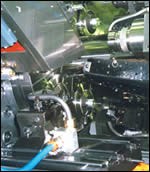Seeing A Multi Through Different Eyes
Sometimes if you don’t 'know' any better, applying technology in new ways simply makes sense. That’s partly what helped drive this family-owned OEM to acquire its first, and so far only, multi-spindle to help it get a better handle on production and inventory control.
The call came in from John Ross, who heads up marketing and sales for Gildemeister Italiana out of DMG’s Chicago tech center. John and I go back a ways, so he knows something about the kind of application story I’m always looking for. I’ve learned to listen when he calls because he’s never sent me goose chasing.
His message was: You need to get over to Bergamo, Italy, for a customer runoff at the Gildemeister Italiana plant. “You’re going to want to cover this one,” he said. For the third time in as many months, I was off to Europe.
Featured Content
At the plant, I met John Lang and Tom Secreto from Otto Controls (Carpentersville, Illinois). John is the machine shop manager and Tom is a supervisor. They represent the customer—whose parts are being runoff on at Gildemeister GMC 35ISM—a full CNC six-spindle multi and Otto Controls first multi-spindle machine tool.
As the Gildemeister techs and John and Tom scrambled around doing the numerous tweaks, nudges and fudges that make up a runoff, we started talking about how and why we Americans all ended up meeting each other on a plant floor in Italy. I scribbled notes as we went through the machine, its options and the interesting manufacturing plan that Otto Controls is implementing with its purchase of this machine tool.
We continued our afternoon conversation over dinner that night at a lovely restaurant in the old section of Bergamo. It’s the medieval part of the town called Citta Alta, which means city in the clouds. As we talked into the night, it appeared that my plane ride to Italy was quite justified. John Ross picked another winner.
Up And Running
Otto Engineering has been in business since 1961. This 450-person company is a vertically integrated OEM with in-house injection molding, stamping, CNC machining, cable assembly and cable overmolding capabilities. It is ISO 9001 certified with mechanical, electrical and radio frequency design engineering capability tied to labs for product and production line testing. The company markets its products through two divisions, Otto Controls and Otto Communications.
The Gildemeister multi is earmarked for use in the machine shop that services Otto Controls. This division’s line of products includes precision switches and control grips used in a variety of applications including heavy equipment, aerospace marine, medical communication and other industries.
The CNC turning department has a wide variety of single spindle machines. Most of the machines are bar fed; several have limited milling capability. There are 14 machines on the floor.
So why would a shop that has a floor full of CNC single-spindle turning centers change strategy and invest in a six-spindle multi? The answer is twofold. It’s about reducing throughput within the shop and, surprisingly, it’s about flexibility.
After our get-together in Italy, the Otto Controls people and I anxiously awaited the delivery of the machine to the plant in Carpentersville. It was delivered on time in June, and after allowing a couple of weeks for installation and training, I was reunited with John Lang and Tom Secreto in their shop.
John met me and took me into the neat-as-a-pin shop. Our first stop, just inside the door, was a chip bin beside one of the single-spindle turning centers. He pointed to the mass of birds’ nests in the bins. “We had to put form tooling on these turning centers to get the cycle times down to about a minute,” John explained. “These chips are a result.”
Then we walked over to the new multi-spindle. He showed me the chips coming off it. “These are what you want,” he beamed, pointing to a bucket of short, nicely broken aluminum chips. “Using single-point tooling on this machine gives us these and the ability to control them, as well as better surface finishes. And, the same part we make on the first lathe I showed you takes about 7 seconds on the multi.” Talk about win-win.
The Problem
As an OEM that machines and assembles its own products, an extensive line of standard and custom switches, inventory control is an issue. Making sure the assembly department, which is the customer for the machine shop, gets the parts it needs when it needs them and in the right quantities is the war that companies like Otto must fight.
“To help us stay competitive,” said John Lang, “we were tasked to find a way to reduce the inventory in our assembly area by 75 percent. The math was simple. Our current inventory turn for a given family of parts was about 1 month. We had to find a way to get that down to about 1 week.”
Innovative Solution
I asked John about the thought process that went into investing in a multi-spindle machine versus using the more conventional turning centers that the shop was familiar with. “We looked at it several ways,” he replied. “We could simply add more spindles to the shop and try to reduce throughput time and hit our inventory bogey that way. However, the addition of more machines would require more floor space and more overhead. After visiting a neighboring shop that was running multi-spindles, we seized on the idea that, in essence, these machines were simply six turning centers on a single base. Rather than investing in six more stand-alone machines, we could get a roughly equivalent number of spindles in one machine. With that idea, a CNC multi-spindle would solve two of our major concerns—floor space and additional overhead.”
As I learned from John during our talks in Italy, the deal breaker was working out a tooling and processing scheme that could make the multi-spindle competitive with single spindle machines in setup and tear-down from job to job.
“We needed to figure out a way to get the flexibility of high-mix, short-run production from a machine tool that designed for low-mix, high-volume,” John said. “Frankly, even Gildemeister was not sure this was a doable thing, but we worked together to find out if it was possible.”
The 35 ISM multi-spindle that Otto chose is a full CNC with 36 axes controlled by two Seimens 840D CNCs designed to “handshake” back and forth to efficiently process the lager blocks of code required to drive that many axes of motion within a reasonable processing time. This internal communication between the CNCs is transparent in the machine’s operation.
Only single-point, indexible insert tooling is used on the multi for turning operations. Quick-change holders attached to compound slides accomplish the turning operations and enable a fast change-over from tool-to-tool and job-to-job. Tools are pre-set off-line and then comped in the machine by assigning offsets that are input into the CNC.
The runoff in Italy proved the concept. Three parts were used to tool and test the machine. These parts represented the widest geometric and feature variation of Otto’s production needs. Results were good. The maximum time for change-over was 30 minutes, using the extremes of part configurations, and the minimum time was 5 minutes when the parts were only slightly different.
Rationalizing Part Families
Three parts is one thing, but Otto’s plan is to run 400 different part numbers across this multi-spindle. Lot sizes average 100 pieces, depending on the requirements of the assembly department.
That goal requires looking at the big picture to get maximum efficiency from the multi-spindle. “We’re convinced, based on the runoff in Italy and the work we’ve done since installation, that the machine is capable of doing what we hoped it would,” says John Lang. “Our job now is to refigure our internal production mix to take the best advantage of the machine tool.
“That involves grouping our 400 parts into families that have the most similar geometric and dimensional features in order to take advantage of the machine’s production capability while reducing the time spent changing over from part to part,” he says. “It also means working with the assembly department and sales to get a good handle on how much to manufacture and when. By getting our inventory to a lower level and learning to work with shorter leadtimes, predicting demand becomes less of a guess.”
Otto’s multi is equipped with an Iemca feeder. The bar feed is designed to handle a full bundle at a time, enabling Otto to run 24/7 and lights out when necessary.
A single bar size is used for the entire family of parts. This small compromise helps keep change-over times down. “The slight increase in extra metal removal on some of the parts is offset by the setup time savings,” says John Lang. “We also get a better price from our material supplier because we buy more stock in a single size, which simplifies their inventory requirements.”
“I can see a time, when we get more proficient with the machine, where we can group families of very similar but simple parts and do double- and possibly triple-drop operations on this machine,” says John Lang. “That would truly maximize the efficiency of this CNC multi.”
Outside The Box
Otto Controls represents a breath of fresh thinking that’s often not as prevalent in metalworking as it might be. Its managers look at a CNC multi-spindle and see six single-spindle turning centers. They see quick-change tooling and rationalized families of parts production as a means to make what’s often considered relatively dedicated technology flexible. And they see CNC programming as the common language bridge between what they’ve always done and what they need to do. If technology is the science of manufacturing, then the art of manufacturing is in applying the technology.
RELATED CONTENT
-
Dry Swiss Machining in Medical
Continuing to build its reputation for creative solutions, this multi-faceted medical device component manufacturer took its Swiss machining operations to a new level to meet a customer’s market demands.
-
How to Get More Efficient Production from Swiss-Type and Multitasking Machines
SolidCAM for multi-axis Swiss type and multitasking machines provides a very efficient CAM programming process, generating optimal and safe Mill-Turn programs, with dramatically improved milling tool life.
-
Turning to an Adhesive for Lathe Workholding
Adhesive cured by ultraviolet light is an option for securing parts for machining that could otherwise distort when traditional, mechanical clamping techniques are used.



.jpg;width=550;quality=60)







